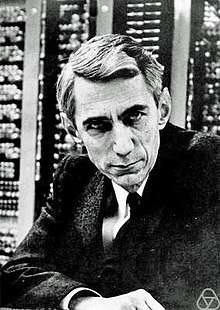Shannon number
The Shannon number, named after the American mathematician Claude Shannon, is a conservative lower bound (not an estimate) of the game-tree complexity of chess of 10120, based on an average of about 103 possibilities for a pair of moves consisting of a move for White followed by one for Black, and a typical game lasting about 40 such pairs of moves.

Shannon's calculation
Shannon showed a calculation for the lower bound of the game-tree complexity of chess, resulting in about 10120 possible games, to demonstrate the impracticality of solving chess by brute force, in his 1950 paper "Programming a Computer for Playing Chess".[1] (This influential paper introduced the field of computer chess.)
Shannon also estimated the number of possible positions, "of the general order of , or roughly 1043". This includes some illegal positions (e.g., pawns on the first rank, both kings in check) and excludes legal positions following captures and promotions.
| Number of plies (half-moves) | Number of possible games |
|---|---|
| 1 | 20 |
| 2 | 400 |
| 3 | 8,902 |
| 4 | 197,281 |
| 5 | 4,865,609 |
| 6 | 119,060,324 |
| 7 | 3,195,901,860 |
| 8 | 84,998,978,956 |
| 9 | 2,439,530,234,167 |
| 10 | 69,352,859,712,417 |
After each player has moved a piece 5 times each (10 ply) there are 69,352,859,712,417 possible games that could have been played.
Tighter bounds
Upper
Taking Shannon's numbers into account, Victor Allis calculated an upper bound of 5×1052 for the number of positions, and estimated the true number to be about 1050.[2] Recent results[3] improve that estimate, by proving an upper bound below 2155, which is less than 1046.7 and showing[4] an upper bound 2×1040 in the absence of promotions.
Lower
Allis also estimated the game-tree complexity to be at least 10123, "based on an average branching factor of 35 and an average game length of 80". As a comparison, the number of atoms in the observable universe, to which it is often compared, is roughly estimated to be 1080.
Number of sensible chess games
As a comparison to the Shannon number, if chess is analyzed for the number of "sensible" games that can be played (not counting ridiculous or obvious game-losing moves such as moving a queen to be immediately captured by a pawn without compensation), then the result is closer to around 1040 games. This is based on having a choice of about three sensible moves at each ply (half-move), and a game length of 80 ply.[5]
Notes and references
- Claude Shannon (1950). "Programming a Computer for Playing Chess" (PDF). Philosophical Magazine. 41 (314).
- Victor Allis (1994). Searching for Solutions in Games and Artificial Intelligence (PDF). Ph.D. Thesis, University of Limburg, Maastricht, The Netherlands. ISBN 978-90-900748-8-7.
- John Tromp (2010). "John's Chess Playground".
- S. Steinerberger (2014). "International Journal of Game Theory". International Journal of Game Theory. 44 (3): 761–767. doi:10.1007/s00182-014-0453-7.
- "How many chess games are possible?" Dr. James Grime talking about the Shannon Number and other chess stuff (films by Brady Haran). MSRI, Mathematical Sciences.